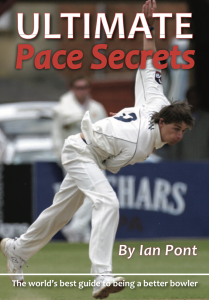
Ultimate Pace Foundation (UPF) is an online cricket coaching platform created by Ian Pont. We invite, inspire and challenge fast bowlers.
We have not yet agreed any coaching dates for camps due to COVID-19. But we do hope to have some UPF camps arranged in the
It’s been three years since we started UPF Cricket online coaching and we are massively proud of the achievement! Many thousands of people have been

Using the results of high motion video analysis of the fastest bowlers on the planet, years of exhaustive clinical research and in-depth biomechanics studies, Ultimate Pace Secrets goes deeper into the bowling action than any book widely available today. But deep and detailed research is useless if it isn’t usable—and that’s where Ultimate Pace Secrets has the edge.
Developed and written by Ian Pont, among the world’s leading fast bowling coaches, Ian’s experience with the ECB, world-class fast bowlers, World Cup teams, first-class cricketers, emerging talent and junior players has given him the ability to transfer his knowledge to bowlers of any level. With easy to grasp, practical coaching methods, following the steps outlined in this book will help any bowler to bowl faster, more efficiently and more accurately.
BOOK YOUR SKYPE MENTORING CALL WITH IAN PONT. If you’ve ever wanted personalised mentoring here’s your chance. You can now enjoy a 121 mentoring chat
If you want to discuss any issues, doubts or just comment on fast bowling, here’s your chance! We have recently launched a “UPF Swing, Seam
It’s Never About The Technique An interesting fact about cricket coaches – some can and some cannot, coach. Yet, the thought is if you have
It was some 30 years ago I had my first epiphany about fast bowling. On my MLB pro tryout with Philadelphia Phillies, the pitching coach
Reprint of Ian Pont’s Article From: Thursday, 18 March 2010 What IS a Qualified Coach? Can anyone else see the point of the Level 1
Podcast 1: What’s the idea behind UPF Cricket? And why is it completely different to any other fast bowling website? Podcast 2: What do UPF
